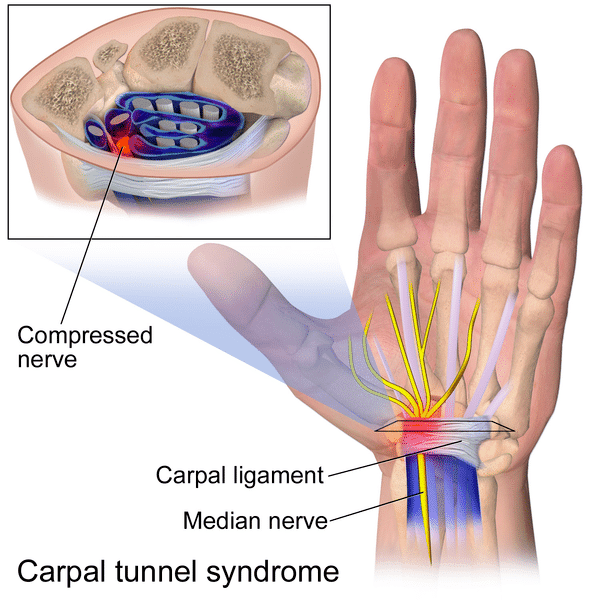
As a species, we are highly dependent on our hands. Without them we can be severely limited in what we can do and how we function.
And if our hands are subject to chronic pain, it can become a serious problem.
A Look at Carpal Tunnel Syndrome
First, we need to look at what carpal tunnel syndrome is and how it relates to exercising and working out.
A good definition, or description, of the condition comes from the Mayo Clinic website,
“Carpal tunnel syndrome is caused by pressure on the median nerve. The carpal tunnel is a narrow passageway surrounded by bones and ligaments on the palm side of your hand. When the median nerve is compressed, the symptoms can include numbness, tingling and weakness in the hand and arm.
The anatomy of your wrist, health problems and possibly repetitive hand motions can contribute to carpal tunnel syndrome.”
Essentially, the syndrome is the result of a pinched, or compressed, nerve. And it is one of the most common ailments suffered by people, especially with so many working with keyboards and computers.
According to the American Academy of Orthopaedic Surgeons (AAOS), the typical symptoms include:
- Numbness, tingling, burning, and pain—primarily in the thumb and index, middle, and ring fingers
- Occasional shock-like sensations that radiate to the thumb and index, middle, and ring fingers
- Pain or tingling that may travel up the forearm toward the shoulder
- Weakness and clumsiness in the hand—this may make it difficult to perform fine movements such as buttoning your clothes
- Dropping things—due to weakness, numbness, or a loss of proprioception (awareness of where your hand is in space)
Carpal tunnel syndrome is usually caused by a combination of factors. Older people and women are more likely to develop the condition, according to studies done. There are many cases caused by “temporary” risk factors such as pregnancy as hormonal changes during pregnancy can cause swelling. In addition, certain health conditions such as rheumatoid arthritis, diabetes, and thyroid gland imbalances are conditions that have been associated with carpal tunnel syndrome.
But the three major risk factors that can lead to carpal tunnel syndrome are heredity, repetitive hand use, and hand and wrist position, according to the AAOS:
- Heredity. This is likely an important factor. The carpal tunnel may be smaller in some people or there may be anatomic differences that change the amount of space for the nerve—and these traits can run in families.
- Repetitive hand use. Repeating the same hand and wrist motions or activities over a prolonged period of time may aggravate the tendons in the wrist, causing swelling that puts pressure on the nerve.
- Hand and wrist position. Doing activities that involve extreme flexion or extension of the hand and wrist for a prolonged period of time can increase pressure on the nerve.

Image courtesy of Blausen.com staff (2014). “Medical gallery of Blausen Medical 2014”. WikiJournal of Medicine 1 (2). DOI:10.15347/wjm/2014.010. ISSN 2002-4436. (Own work) [CC BY 3.0], via Wikimedia Commons]
Carpal Tunnel Syndrome and Working Out
According to research, your workouts are very unlikely going to cause carpal tunnel syndrome. However, if you already suffer from carpal tunnel syndrome, or are predisposed to it, the action of consistently bending or flexing your wrist while you work out can irritate the median nerve and worsen the symptoms.
What does this look like in practical terms?
Common exercises such as planks, push-ups, mountain climbers, burpees, snatches, and overhead squats could make your carpal tunnel syndrome symptoms worse.
Among weightlifters, a significant number of participants are likely to develop carpal tunnel syndrome with certain movements, as well. According to one survey,
“From the sample of 50 community members who participated in the poll, ranging from bodybuilders, general health and wellness, and those in medicine: 24 members (48%) developed CTS through weightlifting; 16 members (32%) from repetitive motion at work; 5 members (10%) from gaming; 3 members (6%) from other causes; and 2 members (4%) developed CTS during pregnancy. As the poll shows, carpal tunnel and weightlifting seem to go hand in hand. This poll by no means comprehensively shows the overall statistics of who is affected by carpal tunnel syndrome.”
So, while not highly likely, it is possible to develop this condition even while working out. More likely, however, any repetitive hand and wrist motions will simply aggravate an existing condition. Either way, the persistent and chronic pain from carpal tunnel syndrome can be treated.
Your Choice for Carpal Tunnel Syndrome Treatment
At Pain and Performance Solutions our goal is to learn everything we can about your current pain along with any history of discomfort. We can only begin treating and relieving your chronic pain once we understand where and how your pain started.
Your trust in us and your honesty are key to our success. The only way to achieve total recovery is by getting your body healthy and working properly.
We do this by first conducting a full examination to help us determine which form of treatment is best suited to put you on your road to recovery. Because your body can compensate for pain to allow you to function during your day, the pain can move or lead to other forms of pain.
Don’t hesitate to reach out. We are here to help and will answer any questions that you may have. You can reach us at (707) 636-4404 or by filling out our online contact form.